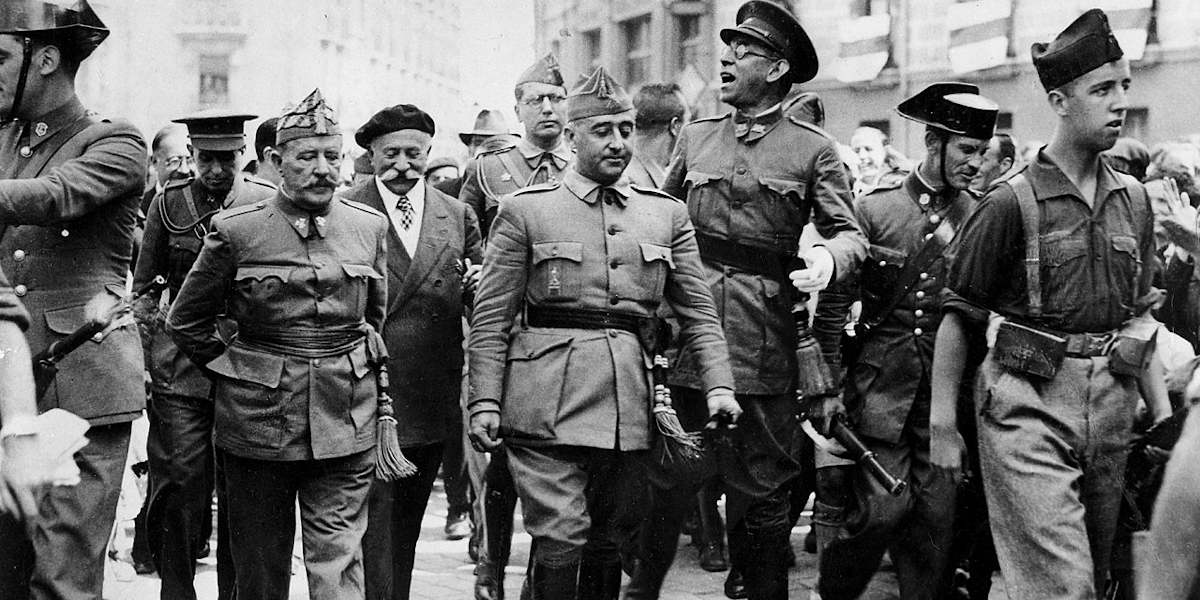The Spanish Civil War was, in many ways, the first war against fascism fought on European soil. Hundreds of thousands died at the hands of fascists, many of them civilians. Systematic killing and extra-lethal violence were no strangers to Francisco Franco’s side. Inflicting terror to subdue the population and win the war was their goal, just like it had been in the colonial wars of the North of Africa during the 1920s. While it is incorrect to call the Spanish Civil War a colonial conflict, it cannot be ignored how Franco, and some of his most loyal followers, first learnt how to command men in this colonial setting, where the enemy was dehumanised.
Fascism is, arguably, the application of colonial violence to the imperial core. Franco implemented what he had learnt during the colonial conflict in the civil war. In his own words:
My years in Africa live in me with an incredible force. There was born the possibility of rescuing a great Spain. There was formed the ideal that redeems us today.
It was Africa, a colonial setting, that taught him how to react to a threat. It taught him how to dominate with fear and violence, and how to implement it in other conflicts, thus importing the colonial warfare to the Spanish peninsula.
Colonial combat
Of course, he was not alone. He had La Legión, officially known as the Tercio de Extranjeros. Created on 28 January 1920 by order of a royal decree, the sole purpose of this new military force was to combat the Berber tribes in the Rif and to aid Spain in its colonial endeavours. The force would be composed of Spanish and European volunteers and would fight alongside the Regulares, the Spanish colonial army troops made up of native moors. Lieutenant Coronel (colonel) José Millán-Astray became the Legion’s commander and official founder, while Commander (later Coronel) Franco served as Millán-Astray’s lieutenant.
Besides being their commanding officer, Millán-Astray was also the ideologist of the Tercio and the reason why they became known as an elite and ruthless force. With the help of Catholicism and his own religious fervour, Millán-Astray shaped a military force that was not afraid of death. By fighting and dying for Spain they had won their place in heaven. ‘You’re here to die! Whoever does not want to die for Spain, make up an excuse and go!’ he screamed in front of new volunteers of the Tercio in 1920 (ABC Madrid, June 1934). Their official motto became ‘Legionnaires to victory, Legionnaires to death’.
Encouraged to dehumanise their enemy, the Tercio quickly became a violent colonial force. Rape, burning villages to the ground and beheadings became normal in the daily life of the legionnaires. They began proudly displaying heads of Moorish prisoners in their camps. The Duchess of la Victoria, who had organised and sent a group of nurses to the battlefield, was thanked with a basket of flowers and two Berber heads.
Franco’s fascism
The coup d’état against the Frente Popular, the leftist government of the Second Spanish Republic, actually started on 17 July 1936 in the Spanish protectorates of Morocco. Franco, who was part of the conspiracy to overthrow the Frente Popular, quickly took the city of Melilla with the legionnaires and the Regulares. Their ruthlessness and professionalism elevated them to elite forces, which contrasted greatly against the forces of the Second Spanish Republic. Franco was subsequently named ‘Superior General of the Moroccan Forces’.
On 1 October 1936, General Francisco Franco was named sole Head of State of the occupied parts of the peninsula. Although he had not been the ideologist of the conspiracy that had triggered the civil war, he had established himself as the leader of the rebel forces through leading the colonial troops.
Spain hasn’t come to terms with its past, colonial or not
Once head of state and official leader of the fascists, Franco sought to carry out a slow war, a war of annihilation, which would completely eradicate the enemy, just as his army had done in Africa. Speeches where the Republicans were compared to the Berbers were given, and the same process of ‘othering’ the enemy was adopted. Meanwhile, La Legión became the protagonist of several massacres during the Spanish Civil War, the most famous one being the taking of Badajoz, where thousands of civilians were executed with no previous trial.
La Legión today
To this day, La Legión still exists and is praised as Spain’s elite forces. In 2019, during an event celebrating its 99th anniversary, Margarita Robles, ex-Minister of Defence and member of the People’s Socialist Party of Spain, claimed that the Legión ‘represents the best of Spain’s history’. She also claimed that ‘if there are any past mistakes [carried out by la Legión]’ then they can ‘learn from them’. By labelling the Tercio’s crimes as ‘mistakes’, Robles purposely ignored the events and conflicts that these forces were involved in, especially by adding the word ‘if’ as if there were no evidence of these crimes.
From torturing two Iraqis during the Iraq War to singing sexist chants during training, the Legión seems to follow the same ideology as when they were created and trained by Millán-Astray and Franco. This comes as no surprise in a country that continuously denies its colonial past, from the genocide perpetrated in the American continent, to the atrocities committed during the Rif Wars. Spain hasn’t come to terms with its past, colonial or not. To this day, 4,265 mass graves with 57,911 victims, most of them unidentified, remain in Spain.
La Legión is praised because Spain ignores and tries to forget its history, and politicians tell us not to ‘reopen old wounds’. By forgetting our history, we are forgetting the victims who, years after the death of Franco, have still not been granted justice.










